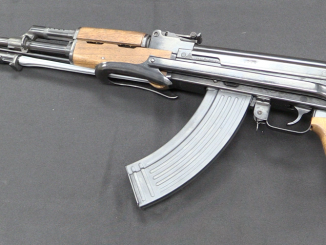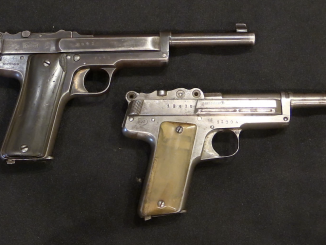During the 1920s and 1930s, a combination of civil wars and international arms embargoes led to a lot of domestic firearms production in China. The size and quality of manufacturing facilities varied widely – everything from massive factories established with European technical assistance to one-man shops only a step or two above being blacksmiths. The weapons produced varied in quality to match. Among other weapons made during this period were handguns mechanically based on several European designs (the Browning 1900, Mauser C96, and Mauser 1910/14, primarily). These handguns show a huge variety of aesthetic designs, gibberish markings, and fake proof marks. They are virtually all single action, simple blowback designs, chambered for .32ACP or 7.63 Mauser. This auction at RIA includes a whole bunch of these pistols, so I picked out a handful of good examples to show some of the elements often seem among them.
You can see the RIA catalog pages for the guns in this video here:
Smaller frame with round butt
Square butt, short barrel, lightening cuts in slide
The one with the “bayonet lug”
The one that locks open on an empty mag
Square butt with ivory-colored grips
Huge & narrow 1900 copy with really long grip
Nicely made Browning 1900 copy




I absolutely love these non-standard and “improvised” pistols, great video as always!
Have you ever gotten your hands on a Type 63 (68) assault rifle?
No, I haven’t – but I would like to!
Bottom row, second from left seems similar to a luger
Long barrel, long handle FN1900 copy, from outer look to functionality, looks like a development over original.
Why didn’t you post the links in the order you talk about them in the video?
I hope you had a chance to take great pictures and notes on all of them for your prophesised book on Chinese mystery pistols. Depending on price I’ll buy a copy. Have you considered buying or casting 10 or so plastic dummy rounds in a few of the common calibers to confirm caliber and magazine capacity?
Buying loads of foreign ammo is one thing, but did China have chambering reamers and loading dies?
Hard to go to war when cartridges don’t fit or cycle.
They probably made their own chambering reamers with a lathe and a mill, or in the worst case (a one-man shop) they used successive drill bits to make a chamber then cleaned it up with emery cloth. May have ground down the diameter of some drill bits to get the right diameter.
For a self-sufficient ammo industry cases have to be stamped(and there has to be sheet brass of the right sort available) and heat treated, bullets swagged, primers made, and smokeless powder made. That involves metalurgy, presses, and a lot of chemistry. It might be easier to make guns from scratch than to make ammo (completely) from scratch, especially if it is not black powder with unjacketed lead.
Here comes the true meaning of “Chinese copy”. It looks like collection of abstract art more than weapons. Illogical, would-be fancy and generally crappy in conception and conduct.
This having said and in comparison, we have current CF-98 Chinese service pistol for sale in Canada – and it looks and works pretty good and – first time ever it is NOT a copy of any known design.
https://www.marstar.ca/dynamic/product.jsp?productid=85807
That way forward trigger position at rest only; once you pull on it, it has some free travel before it engages the sear. For repeat shot it stays in more-less natural mid position. Price is also very reasonable.
İt is in rotating barrel type of lock and has a built in suppressor adaptable recoil spring as well as know.
Here is detailed report: http://thegunforum.net/viewtopic.php?f=2&t=26&start=0&view=print
One thing I noticed in some other review as well, it had reportedly weak trigger return spring to begin with which gets weaker with time. I’d be hesitant to take on it, although I like rotary action.
CF98 is well known and huge demanded pistol at that geography. It has good design features like DA trigger with both side decocker on the frame, rotary barrel lock, push feed loading ensureing positive ejection even without magazine but suffers of rather crude workmanship. Trigger spring is small but moving members are jointy with bigger mass. A new spring of better material and even with slightly, bent up from the middle, forcing arms may solve the problem. Some gunsmithing may be needed if purchased.
If one does not have access to quality firearms, one improvises. The improv weapon does not have to last out the war. It just has to kill an enemy from whom quality weapons can be looted. Let a Pole do this and kill a dread Nazi and you lot swoon at his ingenuity. Let a Chinese do this and you sneer at his subpar aesthetics.
What appears to be serial numbers on the pistols may not actually be serial numbers in many cases. They may be just more decorative markings copied from a sample pistol. If they copied a pistol and the original had some western style Arabic numerals on the side, the maker may simply have copied that or some other number in the same place. If he made several pistols, the same “serial number” may be on all of them.
The only real way to tell if the serial number is a functional serial number would be to get a sampling of identical pistols and check to see if the serial numbers differed.
Pistols made in actual factories producing under contract from an army of some sort are more likely to have functional serial numbers since the buyer would likely have specified them for their own inventory and tracking purposes.
7,63 mauser blowback ?! * KA-BOOM ! * 🙁
Chinese 7.63mm’s do not KA-BOOM. Their Newton is different.
Back in the 70s, Chuck Taylor wrote a column about one of these type of guns in Soldier of Fortune magazine so when I ran across one of thse at a local gunshow I paid the asking price of $5 for it. Mine is one of the long barreled versions with the sculpted “tangent sight” with letters and numbers stamped decoratively all over. It also has grips made of horn. It’s very interesting to see others of this sort come ot light. Thanks,Ian, for the video and info on thses.
I’d not mind that giant 1900… I really like that idea!
No.1944, the ivory-gripped one Ian showed right after it, and No.1942 might look “Mauser-like” externally, but based on slide/barrel geometry, and what I suspect is the safety ahead of the grip on the left side, mechanically they are more probably based on the Beretta blowbacks going back to the 1923 model in 9 x 19mm Glisenti (the downloaded 9 x 19mm Para variant loading used in Italian service pistols in WW1). Specifically, I’m betting they were based on the Beretta M1935 in 7.65mm (.32 ACP).
No.7056 wouldn’t have looked out of place in one of those 1960s Italian “Space Patrol” SF epics directed by Antonio Marghereti.
As for firing the high-pressure 7.63 x 25mm or 7.62 x 25mm in a straight blowback, keep in mind that Hi Point here in the U.S. builds straight blowbacks in .40 S&W, and the old H&K VP-70 was a straight blowback in full-power (Bundeswehr-issue) 9 x 19mm. So it’s certainly possible.
I note that the chamber on 7056 is larger and has thicker metal than the rest of the barrel; intended to contain the firing pressures of the Mauser/Tokarev round?
The “USA”-marked pistol is almost certainly chambered for either .380 ACP or .38 ACP (NOT Super). The magazine dimensions vs. bore size would indicate either of them over 9 x 19mm. “USA” could be an attempt to call attention to the different chambering; “American” cartridge rather than a “European” one. (Yes, this is a SWAG.)
Finally, the grips on the really nice 1900 copy are interesting. They don’t look like wood, and I’m wondering if they aren’t actually pour-moulded lacquer. Don’t forget that the lacquer tree (Rhus verniciflua) is native to China, and its sap was the first “industrial plastic”, used for everything from cooking utensils to jewelry boxes and even coffins in China going back to the 13th Century BC. The lacquer is a plastic varnish which when hardened is incredibly tough, and resistant to breakage, acids, and temperatures up to 500 degrees F.
Sword scabbards, bow cases, and shields were made of it throughout China’s history. So it’s not too big a stretch to suppose that this local resource was used to duplicate moulded-Bakelite grips on FN-made 1900 automatics in the 20th Century.
Which would be sort of ironic, as Western industrial chemists spent over 150 years (from the late 1700s to the early 1900s) trying to duplicate Chinese lacquer as a commercial material, mainly for cookware. Our modern plastics industry is largely the result of European and American research in creating a “local” version of lacquer. One of the earliest commercially-viable results was…Bakelite.
(This was after spending over 200 years trying to duplicate Chinese porcelain, which was an even more formidable challenge. Good porcelain clays are rare outside of Asia, due to purely geologic factors.)
Reference;
Temple, Robert. The Genius of China; 3,000 years of Science, Discovery, and invention. New York; Simon & Schuster, 1986. Based on the work of Dr. Joseph Needham, FRS, FBA. (You can probably find it at Amazon.)
cheers
eon